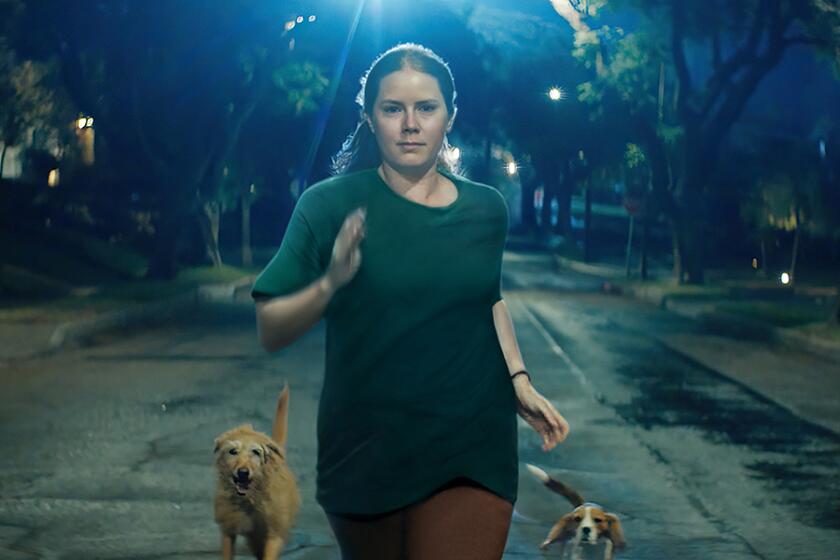Diego Luna’s Cesar Chavez movie marches in Mexico
HERMOSILLO, Mexico — The temperature was climbing past 100 degrees, humidity not far behind. Mexican actor Diego Luna, in the director’s chair for a change, was trying to re-create 1960s California on a set in this industrial city in Mexico’s northern Sonora state.
The performers’ wigs were wilting, their brows brilliant with sweaty shine. Vintage suits in unbreathable polyester double-knit didn’t help. Yet tempers remained surprisingly calm as scenes were shot over and over.
Luna is directing what is being billed as the first feature film about Cesar Chavez, the Mexican American union leader who organized farm workers in California and across the southwestern United States and led two historic grape boycotts aimed at drawing attention to harsh conditions in the fields.
It is only Luna’s second outing as a feature director and his first on a primarily English-language film. Michael Peña (“Crash,” “Million Dollar Baby”) stars as Chavez, and America Ferrera (“Ugly Betty”) plays his wife, Helen. Rosario Dawson takes on the role of Chavez’s longtime organizing partner, Dolores Huerta.
“It’s a struggle,” Luna said of the language, speaking during a break in Hermosillo’s downtown plaza, where the city’s Art Deco-ish public library was doubling as one of the large fruit companies that Chavez targeted. “Directing means choosing the right words. I don’t like those directors who act the part for you, and that’s the temptation when you don’t speak the language.”
But Luna, who spends roughly half his time in Los Angeles these days, was holding his own on the set one day last month, speaking in English to the American actors, switching to Spanish for the extras and much of the crew. He went back and forth between shouting “Action!” and “¡Acción!” at the start of each take.
Although Chavez, who died in 1993, was an American and did most of his work in the U.S., it has taken a Mexican company, Luna’s Canana Films, to make the picture, most of which is also being shot in Mexico. The filmmakers make no bones about choosing the positive aspects of Chavez’s life and not the darker side, such as his authoritarian tendencies, but they insist the film is not simplistic hagiography. Pablo Cruz, one of Luna’s producing partners, acknowledged that some Mexican American filmmakers have been rankled by the idea of a Mexican production company telling the story of a Chicano hero.
“It was very hard — and it’s a little sad — in this day and age in the United States to find money for this type of film,” said Keir Pearson, who penned the screenplay for “Chavez.”
Pearson, a 2005 Oscar nominee for his”Hotel Rwanda”script, said he spent two years negotiating with Chavez’s heirs and acquired the life rights about a year ago, succeeding where a number of others before him had failed. Luna and his fellow producers were able to secure funding, much of it from Mexican sources, Pearson said. (A spokeswoman for the production company said the film had a budget of $10 million. It is scheduled for release in 2013; Participant Media recently announced it has acquired North American rights.)
The decision to film in Mexico was not just a matter of lower production costs and because the producers lived in Mexico. There was a critical visual element — it’s impossible to find the 1960s style of vineyards in today’s California. But in Sonora, home to nearly all of Mexico’s production of table grapes, the old system of draping grape vines on wooden crosses remains common.
“We traveled around California and nothing looks like it did in the ‘60s and ‘70s,” Luna said. Sonora, which borders Arizona, “has the immensity of the fields that you saw in California, where you look forward, back, left, right, it doesn’t end. You feel you can feed the whole country.”
Cesar Chavez was born in Yuma, Ariz., in 1927 and moved with his parents and brother to California in 1938. The family worked in the fields of Central California as migrant farmers. Chavez’s formal education ended in the eighth grade. After a stint in theU.S. Navy, he befriended Fred Ross, a labor organizer who changed the course of his life.
Chavez joined Ross’ community service organization, started working on voter registration drives and in 1962 founded what would become the United Farm Workers. Through the grape boycotts, a series of hunger strikes he staged and a 340-mile march from Delano (near Bakersfield) to Sacramento, Chavez drew global attention to the plight of farm workers, winning them improved living and working conditions, contracts and better pay.
The Canana crew constructed shacks to look like the miserable housing assigned to pickers in the time of Chavez’s work of the 1960s and ‘70s and used a dusty 40-acre plot outside Hermosillo to represent the fields around Delano. In fact, the hot, sticky shooting at the Hermosillo library was a piece of cake compared to the work in the field, Luna and several actors said. Searing sun, dust storms, bugs, actors dropping from dehydration: great conditions for grapes maybe, not so much a film production.
“We ate so much dust in the last weeks,” Luna said.
Luna, Pearson and several others involved in the production said they hoped to capture the best of Chavez’s legacy: his use of nonviolent protest to attempt to improve the plight of the downtrodden. They hope to educate younger generations, for whom “Cesar Chavez” may be little more than a name on a school or street.
The filmmakers said they showed every draft of the script to the Chavez family, incorporated many of the family’s numerous notes, anecdotes and comments, and enjoyed access to abundant archival material retained by the Cesar Chavez Foundation.
“I want them to be happy, pleased,” Luna said of Chavez’s descendants. “But we can deliver the film that we think is right. I hear the story from them, but it’s your angle. What mattered to me the most is … what connects to me.” In the end, he said, “it becomes a film that is directed by someone.”
Added Cruz: “This is the first time Chavez is portrayed on film. We are not making an exposé.”
The film will also pay homage, Luna said, to those who worked with Chavez, his followers and community, and it will focus on the period surrounding the grape boycotts of the 1960s and ‘70s, perhaps avoiding the later years of the United Farm Workers’ decline and what many contend was Chavez’s mismanagement.
The UFW today has lost most of the clout it obtained under Chavez. Its membership has plummeted, and it has allowed numerous contracts with growers to lapse. A new line of study now suggests Chavez might have inspired a movement but was unable to run a union.
“It’s about Cesar Chavez, but it is also the story of an event that changed the life of a community and the perception the country had of this community, the seed he planted in the community and how it spread and gave confidence to a community that had been invisible,” Luna said. “They found strength in their numbers and realized they could use their voice para una misma consigna [for a single slogan], and they could be powerful and collapse an adversary.”
Luna said he also wants to use the Chavez story as a vehicle to illustrate the Mexican American experience. Few Mexicans know who Chavez was, Luna said (and many Americans to this day think he was Mexican). Nor do Mexicans completely understand or appreciate the way Mexican Americans live, with an eye on their past, a constant struggle to belong to their present and a desire to achieve equal standing among other American citizens.
“I hope the film brings out the complexity and challenges the audience on how much they really know the other side,” said Luna, 32, whose 3-year-old son was born in Los Angeles and is, thus, a Mexican American.
Cruz hopes that Canana’s reputation for quality, niche movies like “Sin Nombre”and “Miss Bala”will win over skeptics. “We share the same values and cultures and have to work together,” he said. “I love the fact that it is us.” (Luna and Cruz’s third partner in Canana Films, actor Gael Garcia Bernal, makes a cameo in the movie.)
Many of the actors seem in awe of the project. Peña grew up in Chicago, the son of Mexican farmers who had immigrated there. He said he knew the name Cesar Chavez but didn’t really know what the activist achieved in terms of raising the voice of the voiceless. Peña said his father nearly wept when the actor told him he was playing Cesar Chavez.
“Now I understand why he got so emotional,” Peña said between takes, looking kind of Leave-it-to-Beaverish in a checkered shirt and slightly bouffant wig (his hair, he said, is not long enough to re-create Chavez’s ‘60s-style waves).
Ferrera, born in the U.S. to Honduran parents, was raised in California and said she always knew who Chavez was and admired him. While Peña could prepare for his role by studying historical footage of Chavez, Ferrera has had to portray a wife who stayed largely behind the scenes during the heyday of the workers’ movement. Helen Chavez, now 85, has met with Ferrera to discuss the history.
Helen “saw her husband’s role and really pushed it” while raising eight children, Ferrera said. “I was daunted. How do we convey the importance of that partnership and her still and quiet strength? … People made enormous sacrifices. You understand [from the movie] that great things don’t happen without great sacrifice.”
Gabriel Mann, on summer hiatus from his turn as Nolan Ross on the TV series “Revenge,” is playing the scion of an orchard-owning family. He sees current-day relevance in the Chavez story. “In these days of union-busting in the States, this shows what happens when there are no protections,” he said. “It’s more timely than ever. It’s a cautionary tale but also uplifting in that the good guys do win.”
Actor John Malkovich joined the Chavez effort initially as a producer through his L.A.-based production company Mr. Mudd. Eventually, Luna recruited him into the role of an abusive grape-grower. He was persuaded to take an on-screen role by his admiration of Luna’s work and a sense that the story was important. “To me, it’s also about simple human fairness,” Malkovich said.
Given that scores of extras were needed to play field hands and fruit company employees, Hermosillo’s relative ethnic diversity was a boon for the filmmakers. Multinational companies likeFord Motor Co.have a long history in the region, so there was a pool of Anglo-looking performers to draw from; for the Filipino fieldworkers, the filmmakers went to Hermosillo’s 67 Chinese restaurants and came up with 16 actors.
The filmmakers also studied speech patterns of the ‘60s and ‘70s, particularly the Chicano dialect, which dialect coach Claudia Vazquez said was markedly different from what is spoken by Mexican Americans in California today.
Ultimately, Luna said, he wants the film to be about something more than one man.
“We want to make sure that we pay tribute to those who fought for the community,” Luna said. “The way [Chavez] approached the struggle could be applied anywhere in the world.”
More to Read
Only good movies
Get the Indie Focus newsletter, Mark Olsen's weekly guide to the world of cinema.
You may occasionally receive promotional content from the Los Angeles Times.











